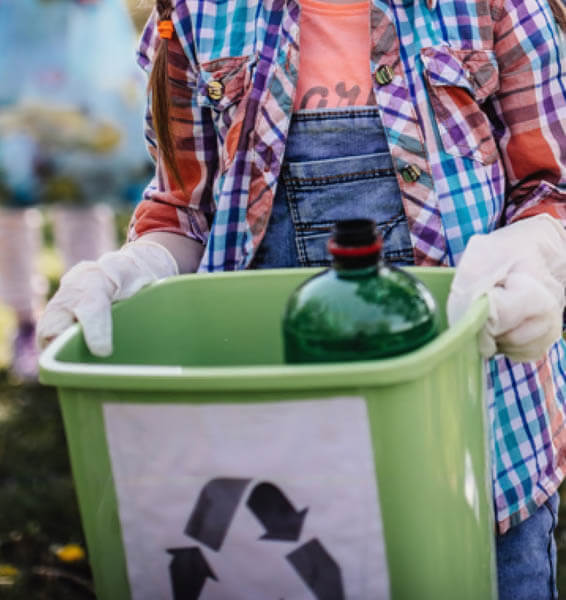In this activity, students explore the impact of single-use plastics by making predictions, gathering data, and analyzing results. This can be used as a starting point for a student-led eco-action activity, such as a letter-writing campaign or a school awareness campaign

Grade level: 4-6
Learning Objectives:
– Recognize the prevalence to single-use plastics and their environmental impact
– Create an action plan to contribute to decreasing the use of single-use plastics
During this activity, students will:
– Undertake a plastic audit
– Analyze the results
– Brainstorm an action plan to reduce the use of single-use plastics
Materials:
- Recycling and garbage bags
- Gloves and hand sanitizer
- Plastic Audit Handout (one per student, pair or group)
- Clipboards and pencils
Setup
Before beginning, identify a location for your class to carry out their plastic audit. This could be the school yard or a nearby park. Determine the boundaries for the activity, when the audit will take place and how long it will take place for. Consult your municipalities website to learn which plastics can be recycled in your area.
Instructions
1. Begin by asking the students the following questions:
- Look around and try to find things that don’t include plastic. Was this difficult to do?
- What do you think is meant by single-use plastics? (If needed, give some examples)
- Why do you think they are a problem for the planet?
Building on the students’ answers, introduce the concept of single-use plastics and the reasons they are a problem for the planet. You can use one of the suggested resources below.
2. Explain that there are many ways to help, but in order to find a solution to this problem, it is important to understand it. To do so, you are going to observe how many and which types of single- use plastics are in the school yard/outdoor space. As responsible citizens, you are going to pick them up and contribute to improving the situation.
3. Distribute the Plastic Audit Handout. Give students some time individually to predict which single- use plastics they think they will find the most of. Discuss as a class and write their predictions on the board.
4. Explain how the observation activity will take place (how much time, location, groups, etc.) and how to fill out the observation part of the handout. Review proper handling of litter (What to do with PPE litter).
5. For the observations, small groups or individual students can be given different areas, or the whole class can observe the same area, depending on your context. Give the students a certain amount of time (i.e. 10 minutes) to observe and pick up litter and record their results.
Results and discussion
Once you have returned to the classroom, combine the observations from each group and prepare the final tally. Compare the predictions and the results and discuss, using the following questions as a guide.
About the activity:
- Why do you think we found so many…?
- Why do you think we use single-use plastics?
Going further:
- Thinking about the single-use plastics we found the most of, what is one way we could deal with this?
- Thinking about why we use single-use plastics, how could we change habits?
- What can we do next to reduce plastic pollution at school?
- What skills do you have that might make you successful at motivating others to stop using single-use plastics?
Next step
Encourage the students to use the results and discussion to create action projects to decrease the use of single-use plastics and the associated litter. This could include learning about current initiatives that are being done around the world to either a) stop single-use plastics b) clean up single-use plastics. Possible action plans could be a letter-writing campaign or a school awareness campaign.
An important step in empowering children to take environmental action, is having them share their knowledge with others. This could be done through:
- Creating a report about the audit for the school newsletter/website
- Share the results with the school through announcements or visiting other classes
References
How Long ‘Til it’s “Gone” Quiz
https://www.earthrangers.com/EN/CA/all/how-long-till-its-gone/
This Earth Rangers Quiz helps students understand the impact of plastics on the environment.
Single-use plastic, microplastics are an environmental disaster (CBC Kids News, 2022, 5 mins)
https://www.youtube.com/watch?v=3d9f1LdTNP8
How Plastic Hurts the World (SciShow Kids, 2018, 4 mins 30 seconds)
https://www.youtube.com/watch?v=VUUUxOl715s
Plastic Pollution, What’s the problem? (Shaw, National Geographic Kids)
https://kids.nationalgeographic.com/nature/kids-vs-plastic/article/pollution-1
This short article explains why plastics are a problem for the environment.
Journey of a Plastic Bag
https://homeroom.earthrangers.com/download-page/?dlm-dp-dl=1948
Plastic bags might seem convenient, but they have a lasting impact on the environment. This Earth Rangers info sheet outlines the environmental cost of a plastic bag.
